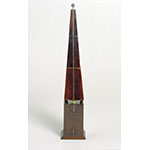This device simulates the potential damage to a building struck by lightning when the lightning conductor is not properly grounded.
There are four sections with a brass conductor running through them. The conductor in the base section is hidden and is connected to a brass hook. At the top of this section is a rectangular cutout into which fits a thin mahogany strip. Depending on how it is inserted, the strip can break or restore the continuity of the conductor. One of the pyramid's spherical feet rests on the mahogany strip and thus also makes electrical contact with the conductor.
When the mahogany strip is arranged so as not to break the conductor circuit, the spark from a Leyden jar at the tip of the lightning conductor is discharged to the ground without damaging the pyramid. But when the conductor circuit is broken by twisting the mahogany strip, a spark gap is formed. The violent discharge from the jar will cause the strip to fall out and the obelisk will fall to pieces. Provenance: Lorraine collections.











